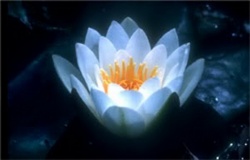Utpala
Revision as of 04:08, 6 May 2013 by VTao (talk | contribs) (Created page with "thumb|250px| utpala (優波羅)—blue lotus. Utpala is a kind of flower which is usually appeared in the Thangka of Tibetan. It rises from mud, and is li...")
utpala (優波羅)—blue lotus.
Utpala is a kind of flower which is usually appeared in the Thangka of Tibetan. It rises from mud, and is like water lily or lotus. Utpala is a symbol of the pure. Several traditional deities of Tibet including Tārā have been depicted holding Utpala flowers in hands. Tārā is a famous deity in Buddhism and is also worshipped by Shakti-worshipping Hindus as well esp. in Eastern India,e.g., Mithila.
In Sanskrit, the neuter noun utpala has two meanings, both given by Amarakoṣa (a lexicon of circa. 400 AD). The first meaning is white lotus also known as kuvalaya in Sanskrit, according to Amarakoṣa.[2][3] The second meaning of utpala is a variety of medicinal plant known as 'kooṭh' in Hindi and 'kusṭham, vyādhi, paribhavyam or pāribhavyam, vāpyam, pākalam' according to Amarkośa.
'Utpala' is often translated simply as blue lotus, a name that hardly seems to do justice to this exquisite flower. Its botanical name is Nymphaea Caerulea. The Blue Utpala is the magic bloom carried by the Goddess Tara and it is simply the best weapon you can use when faced with difficult people who only seem to cause problems in your life. The blue, indigo, or black lotus is specifically indentified as the utpala or ‘night lotus’ in Indian Buddhist Sanskrit texts. Since the lotus does not grow in the high altitudes of Tibet, the Tibetans later adopted this term to cover all varieties and colors of lotus blossoms. The blue lotus was especially venerated in ancient Egypt, where its petals were steeped in water, tinctured in alcohol, or distilled into an essential oil to produce a potent and rejuvenating aphrodisiac panacea. The term utpala means ‘to burst open’ or ‘without flesh’. The name utpala-naraka is applied to one of the eight cold hells of Buddhist cosmology, where the skins of its denizens turns blue from the intense cold and bursts open into utpala-like cracks. The blue utpala lotus is an attribute of Green Tara and many other Vajrayana deities. It is also known by the Sanskrit terms nilabja, nilotpala, pushkara, and nilanalina.
Utpala, a term used for the curly-petaled flower that in the Chinese tradition is a symbol of longevity or renewal -- the peony.However, "utpala" is sometimes taken to mean a lotus, and may also refer to a multi-bloomed flower such as the rhododendron that comes in many colours, or even the anemone.
Source
www.sutrasmantras.info [[Category:]Buddhist Terms]
